ASRock 939SLI32-eSATA2: ULi Dual x16 SLI
by Gary Key on March 2, 2006 12:15 PM EST- Posted in
- Motherboards
Audio Performance
The Realtek ALC-660 HD audio codec was tested with the recently released 1.31 driver set. The Realtek DirectSound audio drivers do not support more than 32 hardware buffers and the OpenAL 1.1 drivers do not support more than 30 hardware buffers at this time. So, the scores cannot be directly compared to the HDA Mystique 7.1 and Creative Labs Sound Blaster X-FI cards in the benchmarks. The Realtek OpenAL 1.1 driver increases CPU utilization up to 20% more than the Realtek DirectSound drivers.
However, if you are a serious gamer, then a dedicated sound card is still a requirement to ensure consistent frame rate averages across a wide variety of games. We noticed in previous testing of our Battlefield 2 and Half Life 2 benchmarks that the Realtek HD audio codecs would cause stuttering in intensive scenes. The 1.31 driver release has now eliminated all stuttering in our current benchmarks while improving performance across the board except in Serious Sam II. We did not notice the same performance degradation in Serious Sam II with the 1.31 driver set and the Realtek ALC-882 codecs on the Intel chipset boards. We are still investigating this issue.
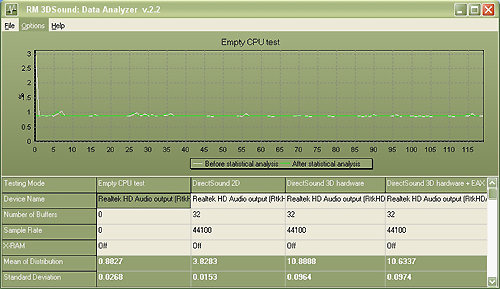

The Realtek ALC-660 HD audio codec was tested with the recently released 1.31 driver set. The Realtek DirectSound audio drivers do not support more than 32 hardware buffers and the OpenAL 1.1 drivers do not support more than 30 hardware buffers at this time. So, the scores cannot be directly compared to the HDA Mystique 7.1 and Creative Labs Sound Blaster X-FI cards in the benchmarks. The Realtek OpenAL 1.1 driver increases CPU utilization up to 20% more than the Realtek DirectSound drivers.

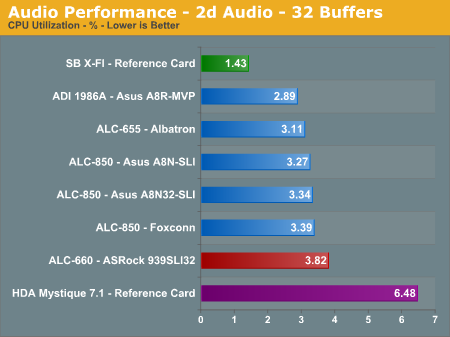
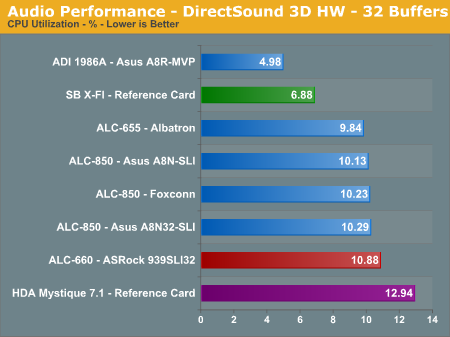
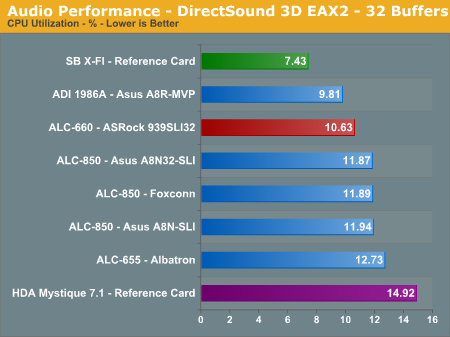
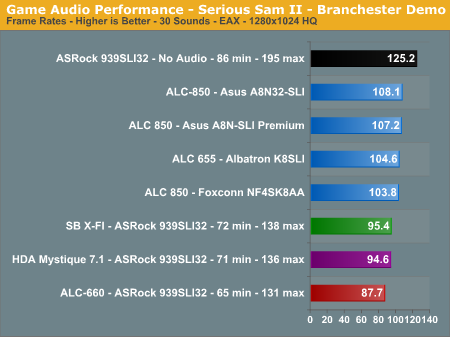
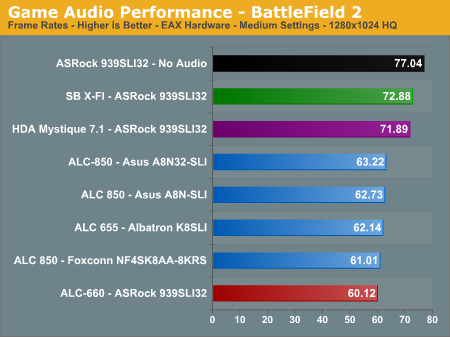
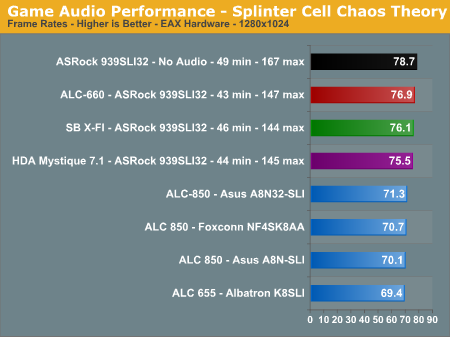

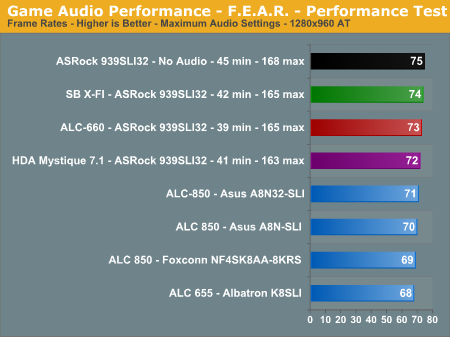
However, if you are a serious gamer, then a dedicated sound card is still a requirement to ensure consistent frame rate averages across a wide variety of games. We noticed in previous testing of our Battlefield 2 and Half Life 2 benchmarks that the Realtek HD audio codecs would cause stuttering in intensive scenes. The 1.31 driver release has now eliminated all stuttering in our current benchmarks while improving performance across the board except in Serious Sam II. We did not notice the same performance degradation in Serious Sam II with the 1.31 driver set and the Realtek ALC-882 codecs on the Intel chipset boards. We are still investigating this issue.
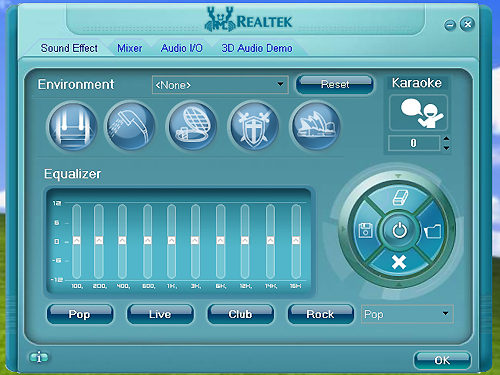
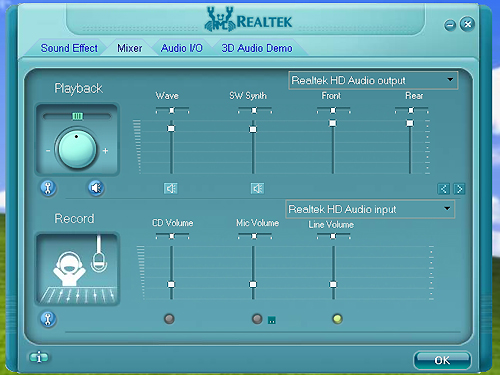
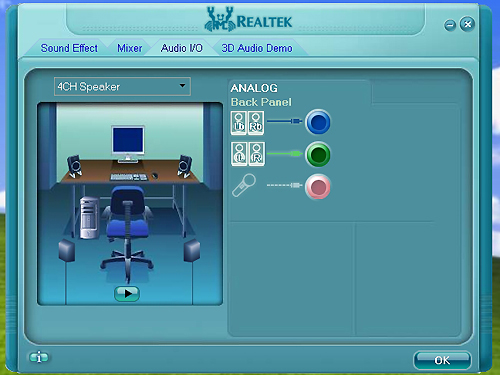










46 Comments
View All Comments
Zoomer - Tuesday, March 7, 2006 - link
This board would cannabilize sales of the premium SLI32 and xfire board that Asus sells for $150 IF it included voltage settings up to 2v vCore, 3.2v vMem, etc.They would be stupid to do it. These people will pay the $150 anyway if they don't have an easy (cheap) alternative. For the rest of us, we can get busy with a 2B pencil, solders or conductive ink. ;) And forgo the warranty on it, so if it goes boom in a year's time, you're on your own.
Nice strategy. Would AT leak the beta bios for comparison's sake? (We'll smuggle it to xs or ocwb....:D)
poohbear - Thursday, March 2, 2006 - link
and for the record the dualsata2 is a very stable mobo @ stock settings, i have to give credit where it's due, but for overclocking this company's products shouldnt even be considered.sandorski - Thursday, March 2, 2006 - link
It kinda sucks Nvidia bought out ULI, they were very innovative and really filled niche markets very well. Then again, perhaps Nvidia will let them continue doing interesting things there?Cygni - Thursday, March 2, 2006 - link
Hard to argue with that... looks like ASRock/ULi has another mega seller on their hand with this baby. But I cant help but wish it had an AGP slot thrown in between the two PCI-Ex lanes, to allow an upgrade path. Thats probably the primary reason the ULi 1695 boards have been selling so well.The IDE and SATA performance numbers are really striking in contrast to Nvidia's. I hope we see the inclusion of ULi's storage controller in future Nvidia chipsets.
All for $85... awesome.
Furen - Thursday, March 2, 2006 - link
If it had an AGP slot then it would have to use ULi's AGP tunnel + the 1697 instead of the 1695 + 1697, which would mean that it'd only have 16 PCI-e lanes for graphics. I suppose most of us wouldn't mind going for two 8x slots while in SLI but then most of us wouldn't really want SLI to begin with.JackPack - Thursday, March 2, 2006 - link
Quality doesn't seem to be bad either. Panasonic and UCC caps in there.